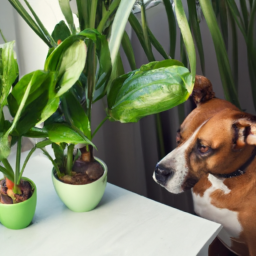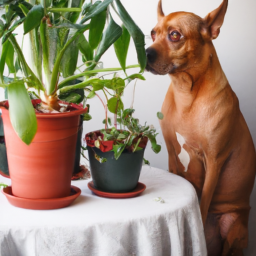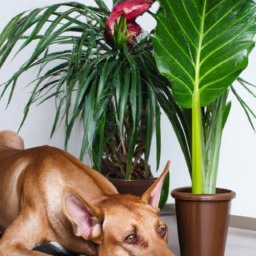
If you’re a proud dog owner and also love to fill your home with greenery, it’s crucial to be aware of what indoor plants are poisonous to dogs. While plants can bring life and beauty to your living space, some varieties can pose a significant risk to our furry friends. As responsible pet owners, it’s essential to educate ourselves about the potential dangers lurking in our indoor gardens. In this blog post, we will explore the various indoor plants that can be toxic to dogs, helping you create a safe and pet-friendly environment for your beloved canine companion. So, let’s dive in and discover which plants to avoid to keep our furry friends healthy and happy.
Common Indoor Plants Toxic to Dogs
As a responsible dog owner, it is crucial to be aware of the potential hazards that certain indoor plants can pose to our furry friends. While plants add beauty and freshness to our homes, some can be toxic to dogs if ingested. In this guide, we will explore the most common indoor plants that are poisonous to dogs, helping you create a safe environment for your canine companion.
1. Sago Palm
The Sago Palm, scientifically known as Cycas revoluta, is a popular decorative plant that can be found in many households. However, it is highly toxic to dogs if any part of the plant is ingested. The Sago Palm contains cycasin, a toxin that can cause severe liver damage and even be fatal to dogs. Symptoms of Sago Palm poisoning include vomiting, diarrhea, lethargy, seizures, and jaundice. Immediate veterinary attention is crucial if you suspect your dog has ingested any part of this plant.
It is important to note that the Sago Palm is not a true palm but rather a cycad, which makes it even more toxic. Keep this plant out of your dog’s reach or consider replacing it with a pet-friendly alternative.
If you are unsure about the toxicity of a specific plant, consult the American Society for the Prevention of Cruelty to Animals (ASPCA) website or contact your veterinarian for guidance.
2. Dieffenbachia
The Dieffenbachia, also known as Dumb Cane, is a popular houseplant due to its attractive foliage. However, it contains calcium oxalate crystals that can cause intense oral irritation if chewed or ingested by dogs. Symptoms of Dieffenbachia poisoning include drooling, difficulty swallowing, pawing at the mouth, and swelling of the tongue and throat. While rarely life-threatening, it is essential to seek veterinary care if your dog shows any signs of ingestion.
To keep your dog safe, place the Dieffenbachia in an area that is inaccessible to your furry friend. Consider hanging it from the ceiling or placing it on a high shelf.
3. Philodendron
The Philodendron is a popular indoor plant known for its heart-shaped leaves and low maintenance requirements. However, it contains calcium oxalate crystals similar to the Dieffenbachia, which can cause oral irritation and discomfort if chewed or ingested by dogs. Symptoms of Philodendron poisoning include drooling, pawing at the mouth, vomiting, and difficulty swallowing. While typically not life-threatening, it is still important to monitor your dog closely and seek veterinary care if necessary.
Place the Philodendron out of your dog’s reach or consider using hanging baskets or elevated plant stands to prevent any accidental ingestion.
Remember, these are just a few examples of common indoor plants toxic to dogs. There are many other plants that can pose a risk to your canine companion. Always research and ensure the safety of any new plants you bring into your home. If you suspect your dog has ingested a toxic plant, contact your veterinarian immediately for guidance.
Creating a dog-friendly environment involves being mindful of the potential hazards within our homes. By educating ourselves about toxic indoor plants and taking appropriate precautions, we can provide a safe and enjoyable space for our beloved dogs.

How to Identify and Keep Your Dog Safe from Poisonous Indoor Plants
Indoor plants not only add beauty and freshness to our homes but also provide numerous health benefits. However, it’s important to be aware that some indoor plants can be toxic to our furry friends. As a dog owner, it’s crucial to identify and keep your dog safe from these potentially harmful plants. In this article, we will guide you through the process of identifying poisonous indoor plants and provide tips on how to ensure your dog’s safety.
Understanding the Dangers of Poisonous Indoor Plants
Before we delve into the identification process, it’s essential to understand why certain indoor plants can pose a threat to our dogs. Dogs are naturally curious creatures and may be tempted to chew or ingest plants, especially if they are easily accessible. Unfortunately, many common indoor plants contain toxic substances that can cause mild to severe health issues in dogs. These can range from gastrointestinal problems, such as vomiting and diarrhea, to more serious conditions like organ failure or even death.
Now, let’s explore some of the most common indoor plants that are poisonous to dogs:
1. Dieffenbachia (Dumb Cane)
Dieffenbachia, also known as Dumb Cane, is a popular houseplant due to its attractive foliage. However, all parts of this plant contain calcium oxalate crystals, which can cause intense oral irritation and swelling if chewed or ingested by dogs. Symptoms may include drooling, difficulty swallowing, and vomiting.
2. Sago Palm
The Sago Palm is a beautiful and exotic plant often found indoors. However, it is highly toxic to dogs. The seeds, leaves, and roots of this plant contain cycasin, a toxin that can cause liver failure in dogs. Ingesting even a small amount can have severe consequences, including vomiting, diarrhea, seizures, and even death.
3. Philodendron
Philodendrons are popular indoor plants known for their heart-shaped leaves. However, these plants contain insoluble calcium oxalate crystals, which can cause oral irritation, intense burning, and swelling of the tongue, lips, and mouth if chewed or ingested by dogs. Symptoms may include drooling, difficulty breathing, and decreased appetite.
Identifying Poisonous Indoor Plants
Now that we have discussed some common poisonous indoor plants, let’s focus on how to identify them to keep your dog safe:
1. Research and familiarize yourself with common toxic indoor plants: Educate yourself about the plants that are known to be toxic to dogs. There are many online resources, including pet poison control websites, that provide comprehensive lists of poisonous plants. Take the time to review these lists and make note of the plants you have in your home.
2. Examine the plants in your home: Carefully inspect each indoor plant you have to determine if it falls into the category of poisonous plants. Look for specific characteristics such as the shape, color, and texture of the leaves. Some toxic plants have distinct features that can help you identify them.
3. Consult an expert or veterinarian: If you are unsure about the identity of a particular plant, it’s always best to consult an expert or your veterinarian. They can provide guidance and help you determine if the plant poses a risk to your dog.
Keeping Your Dog Safe
Now that you can identify poisonous indoor plants, let’s discuss some measures you can take to keep your dog safe:
1. Remove toxic plants from your home: If you have identified any poisonous indoor plants, it’s best to remove them from your home altogether. Find alternative non-toxic plants that can still provide the aesthetic appeal without posing a risk to your dog’s health.
2. Restrict access to plants: If removing the plants is not an option, consider restricting your dog’s access to them. Place them in areas that are inaccessible to your dog, such as high shelves or hanging baskets. Be mindful that some dogs are excellent climbers, so ensure the plants are truly out of reach.
3. Train your dog: Training your dog to avoid chewing or ingesting plants is an effective way to keep them safe. Use positive reinforcement techniques to discourage them from approaching or showing interest in the plants. Reward them with treats or praise when they demonstrate appropriate behavior.
4. Provide safe alternatives: Dogs often chew on plants out of boredom or to satisfy their natural urge to chew. Offering safe chew toys or treats can redirect their attention and prevent them from seeking out potentially toxic plants.
5. Supervise your dog: Whenever your dog is in the vicinity of indoor plants, ensure they are under close supervision. This allows you to intervene immediately if you notice any attempts to chew or ingest the plants.
By following these steps, you can create a safe environment for your dog and enjoy the benefits of indoor plants without worry. Remember, prevention is key when it comes to protecting your beloved furry friend from the dangers of poisonous indoor plants.

Pet-Friendly Alternatives: Non-Toxic Indoor Plants for Dog Owners
As a dog owner, it’s important to create a safe and healthy environment for your furry friend. While indoor plants can add beauty and freshness to your home, some plants can be toxic to dogs if ingested. However, there are plenty of pet-friendly alternatives available that can provide the same aesthetic appeal without posing any harm to your beloved pet. In this article, we will explore some non-toxic indoor plants that are safe for dogs.
1. Spider Plant (Chlorophytum comosum)
The spider plant is a popular choice among dog owners due to its non-toxic nature. This plant has long, arching leaves with green and white stripes, adding a touch of elegance to any indoor space. Spider plants are known for their air-purifying properties, making them an excellent choice for improving the air quality in your home.
Spider plants are relatively low-maintenance and can thrive in various lighting conditions, from bright indirect light to low light. They prefer well-draining soil and should be watered when the top inch of soil feels dry. Avoid overwatering, as it can lead to root rot.
With its non-toxic nature and air-purifying benefits, the spider plant is an ideal choice for dog owners looking to enhance their indoor space without compromising their pet’s safety.
2. Boston Fern (Nephrolepis exaltata)
The Boston fern is another pet-friendly indoor plant that adds a touch of lush greenery to your home. Its feathery fronds create a beautiful cascading effect, making it a popular choice for hanging baskets or as a tabletop centerpiece.
Boston ferns thrive in bright, indirect light and prefer a humid environment. It’s important to keep the soil consistently moist, but not soggy. Misting the fronds regularly can help maintain the required humidity level. These ferns are relatively easy to care for and can be a great addition to any dog-friendly home.
Not only does the Boston fern provide a refreshing aesthetic, but it also acts as a natural air humidifier, releasing moisture into the surrounding environment. This can be particularly beneficial during dry winter months when indoor heating systems can cause dryness in the air.
3. Areca Palm (Dypsis lutescens)
The Areca palm, also known as the butterfly palm, is a non-toxic indoor plant that adds a tropical touch to your home decor. Its feathery, arching fronds create an elegant and vibrant look, making it a popular choice among interior designers.
Areca palms thrive in bright, indirect light and prefer well-draining soil. They are relatively low-maintenance and can tolerate occasional underwatering. However, it’s important to avoid overwatering, as it can lead to root rot.
In addition to its non-toxic nature, the Areca palm also acts as a natural air purifier, removing toxins such as formaldehyde, xylene, and toluene from the air. This makes it an excellent choice for dog owners looking to improve the air quality in their homes.
Conclusion
Creating a pet-friendly environment doesn’t mean you have to compromise on the aesthetics of your indoor space. By choosing non-toxic indoor plants like spider plants, Boston ferns, and Areca palms, you can enjoy the beauty of nature while keeping your furry friend safe.
Remember to always research the toxicity of any plant before introducing it to your home, as some varieties may have different levels of toxicity. Additionally, it’s essential to monitor your dog’s behavior around plants and seek veterinary help immediately if you suspect your dog has ingested a toxic plant.
With these pet-friendly alternatives, you can create a harmonious living space where both you and your dog can thrive.
In Summary
Indoor plants can bring life and beauty to our homes, but as dog owners, we must be cautious about the plants we choose. While some plants can be harmless, others can be toxic to our furry friends. It’s important to be aware of which indoor plants are poisonous to dogs to ensure their safety.
One common indoor plant that can be harmful to dogs is the popular peace lily. Although its elegant white blooms can be a stunning addition to any room, peace lilies contain calcium oxalate crystals that can cause irritation and swelling in a dog’s mouth and throat. Another plant to watch out for is the philodendron, known for its heart-shaped leaves. This plant contains insoluble calcium oxalates, which can lead to drooling, vomiting, and difficulty swallowing if ingested by dogs.
Other toxic indoor plants include the snake plant, also known as mother-in-law’s tongue, and the pothos plant. Both of these plants contain compounds that are toxic to dogs and can cause symptoms such as nausea, vomiting, and diarrhea. Additionally, the popular aloe vera plant, known for its healing properties, can be harmful to dogs if ingested in large quantities. It can cause gastrointestinal upset and even lead to tremors and changes in urine color.
To keep our canine companions safe, it’s crucial to do our research and choose indoor plants that are non-toxic to dogs. Some safe options include the spider plant, Boston fern, and the African violet. However, it’s always best to consult with a veterinarian if you have any doubts or concerns about specific plants. By being mindful of the plants we bring into our homes, we can create a beautiful and dog-friendly environment for everyone to enjoy.
FAQ Compilation:
Q1: Are there indoor plants that are poisonous to dogs?
A1: Yes, there are several indoor plants that can be toxic to dogs if ingested. It’s important to be aware of these plants to ensure the safety of your furry friend.
Q2: What are some common indoor plants that are poisonous to dogs?
A2: Some common indoor plants that are toxic to dogs include lilies, philodendrons, pothos, snake plants, and peace lilies. These plants contain substances that can cause gastrointestinal issues, vomiting, drooling, and even more severe symptoms if consumed by your dog.
Q3: How can I prevent my dog from getting poisoned by indoor plants?
A3: To prevent your dog from getting poisoned by indoor plants, you can take several precautions. Firstly, make sure to keep all toxic plants out of your dog’s reach, either by placing them in areas that are inaccessible or by using hanging baskets. Additionally, consider using pet-friendly alternatives like non-toxic plants or artificial plants to decorate your home.
Q4: What should I do if my dog ingests a toxic indoor plant?
A4: If you suspect or witness your dog ingesting a toxic indoor plant, it is important to act quickly. Contact your veterinarian or a pet poison helpline immediately for guidance. They will provide you with specific instructions based on the plant ingested and the symptoms your dog is experiencing.
Q5: Are there any indoor plants that are safe for dogs?
A5: Yes, there are many indoor plants that are safe for dogs and can even provide some health benefits. Some dog-friendly indoor plants include spider plants, Boston ferns, money plants, and areca palms. These plants not only add beauty to your home but also help improve air quality. However, it’s always best to research and confirm the safety of any plant before introducing it to your home.
Dr. Olivia Green is a botanist with over two decades of experience in indoor plant cultivation. She holds a Ph.D. in Plant Biology and has dedicated her career to researching plant behavior in controlled environments. Dr. Green is passionate about helping plant enthusiasts master the art of indoor gardening through her extensive knowledge and practical insights.


